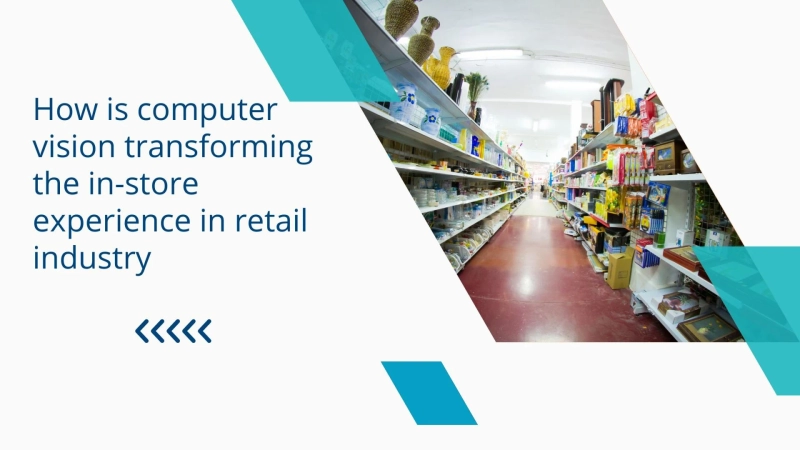It shouldn't be unexpected that retail organisations are becoming more interested in computer vision given the fact that many retail operations demand visual feedback and produce a lot of data. Computer vision could be an amazing retail execution solution but sadly only 3 percent of merchants now use computer vision technology, and 40 percent aim to do so in the next two years, according to a study. Companies may address several retail store pain issues and even alter the experiences of both customers and employees by turning to computer vision software development. For instance, by making judgments on the improvement of shop layout based on actual data rather than intuition, client journeys might be redefined.
Consumers today anticipate the same level of personalisation and convenience in physical stores as they do online. Applications for virtual reality retail are also growing in popularity for this reason. Self-checkout experiences are made frictionless by computer vision cameras, and previously unheard-of levels of personalisation are made possible by virtual mirrors. With the help of autonomous robots, routine operations may be automated, giving staff more time to focus on tasks that benefit customers.
Retail digital transformation becomes much more feasible with machine learning advice and a comprehensive strategy for computer vision deployment. Below are top application of computer vision in retail industry
What is computer vision?
The goal of the artificial intelligence (AI) discipline of computer vision is to make it possible for machines to identify and comprehend things in the physical world. The "eyes" of the machine are actual cameras. An algorithm that can process photos or video serves as the object's "brain." And as soon as the camera turns on, the algorithm begins to examine the surroundings and react to what it finds.
Improved customer service with self-checkouts
Customers are used to seamless internet interactions. And they now anticipate the same degree of comfort in stores as well. Utilising self-checkouts is one approach to deliver it to them. Customers can utilise self-checkout machines, commonly referred to as assisted checkouts, to scan barcodes and make payments without a human cashier present. We can all agree that this is wonderful news since it means less lines and more consumers can check out in less time at these stations.
Self-checkouts are a fantastic method to save expenses while still offering quick service. However, self-checkouts are not without flaws. Since consumers may place products in baskets without having them initially scanned, it is more difficult to stop stealing. However, you may also employ computer vision to find a solution to this issue. Computer vision in this regard could be used to eliminate queuing altogether.
Efficiently managing inventory
Using computer vision in retail inventory management is also becoming more common. In the next two years, 64 percent of retailers plan to implement various data-driven solutions, including computer vision, to improve inventories.
For instance, Shelfie notifies personnel when items are positioned wrongly or when there are gaps on shelves using computer vision cameras set on top of typical retail shelves. This allows the workers on the sales floor to concentrate more on providing excellent customer service. Additionally, adequately stocked shelves significantly boost customers' tendency to buy. Additionally, Shelfie may be used by retail businesses to dynamically rearrange items and promote real-time data-driven decision-making. Some businesses choose a somewhat different strategy, creating comprehensive inspection systems.
Improves Store layout to a great extent
Retailers can watch customers' movements throughout the shop to detect their purchasing patterns, "hot spots," and behaviour in connection to certain items by deploying computer vision cameras. Retailers may use this information to make educated decisions regarding product placement, shop design, and personnel.
The capacity to adjust performance as needed is essential for short-term marketing efforts. A brand may collect footprint, dwell time, product interaction, and demographic information in various retail zones by installing a number of in-store computer vision cameras around the store. With the use of this information, the brand is able to determine which areas have the greatest influence on conversion, when the store was understaffed, and which messaging was most successful in luring onlookers..
Reducing dressing room queries with virtual mirrors
A regular mirror with a display mounted behind the glass is referred to as a virtual mirror. Virtual mirrors using computer vision cameras and augmented reality (AR) may display a variety of contextual data that improves client engagement with the company.. Although a new technology, virtual mirrors are already quite well-liked. The gadget enables the user to try on clothing virtually whether they are at the store or not, by simulating them standing in front of a mirror on screen.
While some virtual mirrors employ augmented reality (AR) to let clients try on garments using their smartphone camera, others use computer vision, harnessing face and image identification methods to turn a picture into a graphical avatar. Based on the user's current attire, the ML-powered engine behind the virtual mirror offers real-time fashion advice. For instance, if someone puts on a hat in the dressing room, the virtual mirror will detect the hat and suggest a purse, jewellery, accessories, and other items that will go well with the outfit.
A store inputs an algorithm with information about each item in their catalogue to make this happen. To provide recommendations for other pertinent things in the shop, the algorithm then takes into account a wide range of item attributes, including as colour, description, price, and gender targeting.
Optimising marketing campaigns with behavioural analytics
Marketers gather information for emotional and consumer behaviour analytics using computer vision (for example, cameras tracking eye movements to determine what customers look at the most). Retail marketers may make the most of displays by positioning seasonal items, like Christmas decorations, in areas where people prefer to gaze. Marketers may also predict a product's prospective appeal using computer vision. Retail execution software that track facial expressions and read client emotions provide marketers with a means to understand how customers react to various products.


